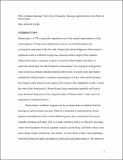Files in this item
Why is Simeon dancing? The unity of exegesis, theology and devotion in the work of Bonaventure
Item metadata
| dc.contributor.author | Hyland, William | |
| dc.date.accessioned | 2019-12-03T10:30:02Z | |
| dc.date.available | 2019-12-03T10:30:02Z | |
| dc.date.issued | 2019-11-15 | |
| dc.identifier | 260325572 | |
| dc.identifier | 9a887fe9-b5c7-4b6a-814f-98f6fe1abfeb | |
| dc.identifier | 85076236115 | |
| dc.identifier | 000497200300006 | |
| dc.identifier.citation | Hyland , W 2019 , ' Why is Simeon dancing? The unity of exegesis, theology and devotion in the work of Bonaventure ' , Spiritus: A Journal of Christian Spirituality , vol. 19 , no. 2 , pp. 267-282 . https://doi.org/10.1353/scs.2019.0031 | en |
| dc.identifier.issn | 1533-1709 | |
| dc.identifier.other | ORCID: /0000-0002-8008-8297/work/65702613 | |
| dc.identifier.uri | https://hdl.handle.net/10023/19045 | |
| dc.description.abstract | Bonaventure (1274) is generally regarded as one of the central representatives of the earliest phases of Franciscan scholasticism, and as a mystical theologian and ecclesiastical statesman of the first rank. Despite this acknowledgement, Bonaventure's significant work as a biblical exegete has witnessed relative neglect from scholars.1 While Bonaventure's academic exegesis is noted by Gilbert Dahan and others as important, particularly the Old Testament commentaries,2 his exegetical writings have received far less scholarly attention than his other works. In recent years, the English translations of Bonaventure's academic commentaries on Luke, John and Ecclesiastes have begun to spur interest in this aspect of his corpus in the Anglophone world.3 Led by the work of the Franciscan Fr. Robert Karris, these translations hopefully will lead to more attention being given to the exegetical aspect of Bonaventure's work, and to its importance in reception history.4 | |
| dc.format.extent | 16 | |
| dc.format.extent | 210724 | |
| dc.language.iso | eng | |
| dc.relation.ispartof | Spiritus: A Journal of Christian Spirituality | en |
| dc.subject | BL Religion | en |
| dc.subject | T-NDAS | en |
| dc.subject | BDC | en |
| dc.subject.lcc | BL | en |
| dc.title | Why is Simeon dancing? The unity of exegesis, theology and devotion in the work of Bonaventure | en |
| dc.type | Journal article | en |
| dc.contributor.institution | University of St Andrews. St Andrews Institute of Medieval Studies | en |
| dc.contributor.institution | University of St Andrews. School of Divinity | en |
| dc.identifier.doi | 10.1353/scs.2019.0031 | |
| dc.description.status | Peer reviewed | en |
| dc.date.embargoedUntil | 2019-11-15 |
This item appears in the following Collection(s)
Items in the St Andrews Research Repository are protected by copyright, with all rights reserved, unless otherwise indicated.

